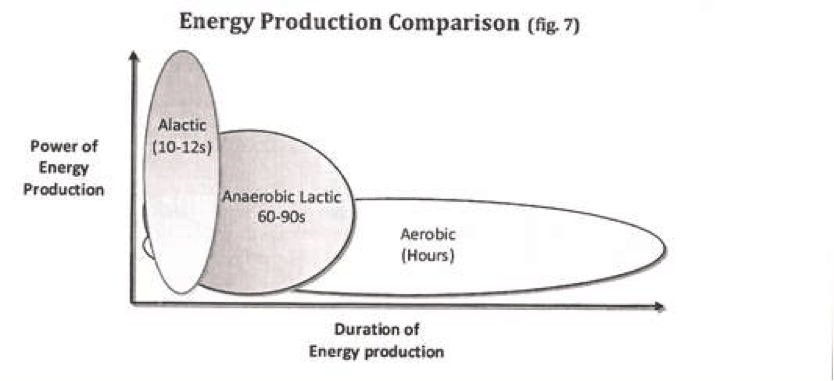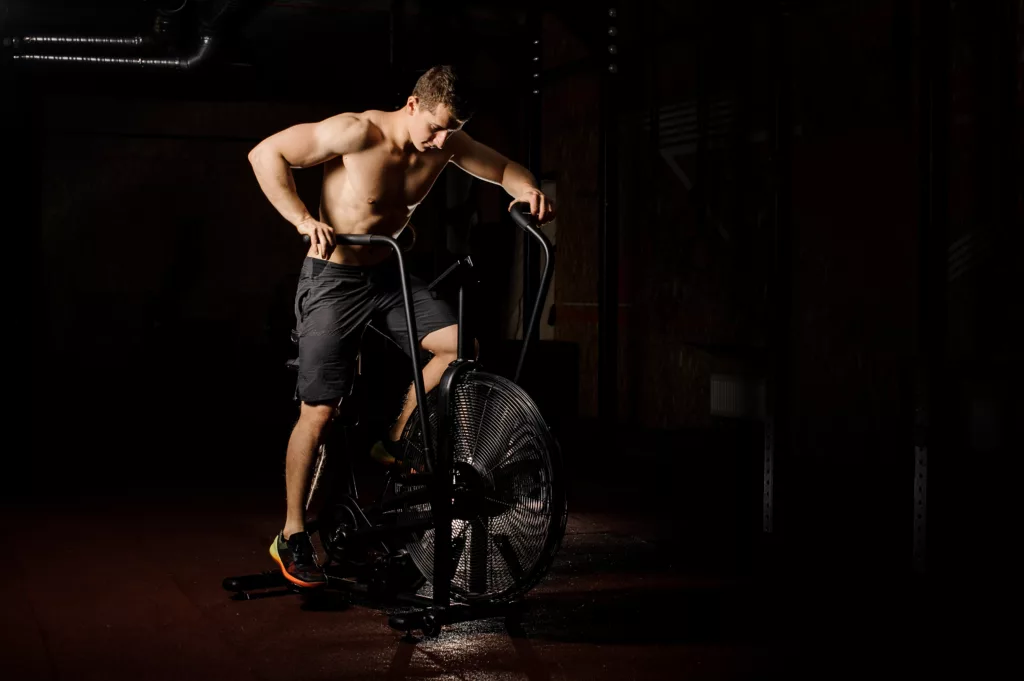Welcome to our ultimate guide to the aerobic energy system, a vital component of human physiology and exercise science.
In this article, we will explore the ins and outs of what this system is, why it demands your attention, and how you can seamlessly incorporate it into your training regimen for transformative results.
For many fitness professionals, understanding and leveraging the aerobic system could be a game-changer, and for some, it could prove life-saving.
This guide is part of an informative trilogy that delves into the three energy systems that drive human performance – the Aerobic, Anaerobic Lactic, and Anaerobic Alactic systems.
To gain a holistic understanding, you might want to explore our guides on the Anaerobic Lactic Energy System and the Anaerobic Alactic Energy System.
Immerse yourself in the fascinating world of energy systems and discover how these invisible forces shape your training outcomes and overall fitness journey.
Table of Contents
Introduction
As an engaged reader and valued member of the Strength Matters community, we want to encourage you to evolve your thinking about fitness. It’s time to go beyond the conventional mindset of sets, reps, workouts, and rest periods.
The real key to unlocking your maximum fitness potential lies in understanding and training energy systems. This shift in perspective will elevate you from a fitness enthusiast to an everyday athlete.
We are fundamentally aerobic creatures. The more we can cultivate our aerobic capacity, the more resilient we become in every aspect of life.
In recent times, fear of losing strength has pushed many towards anaerobic high-intensity interval training (HIIT), at the cost of neglecting aerobic training.
However, this overlooks the crucial importance of aerobic fitness.
Here at Strength Matters, the aerobic energy system is paramount in our approach. Its significance is unmatched, serving as the bedrock of any training program we design.
A well-cultivated aerobic system provides substantial benefits to all other energy systems. It boosts recovery speed, enabling quicker return to effort and increased work volume. Furthermore, it enhances almost every physiological function in the body.
Imagine recovering faster between sets, burning more fat, and improving your body composition. Or in terms of general health and vitality, picture enhancing your immune system function, cognitive performance, digestion, and cardiovascular health.
Given that heart disease remains a leading cause of mortality, the importance of a robust heart cannot be overstated.
At Strength Matters, we prioritize health above all else. A healthier life begins with a stronger aerobic energy system. It’s time to embrace this perspective and unlock your full fitness potential.
The Three Energy Systems
There are three energy systems. The body draws on all three, regardless of the type of effort you put in. They merely change in the amount of energy they contribute depending on the duration and intensity of the effort.
They are:
- The ATP-PC system, or alactic system
- The Anaerobic glycolysis, or lactic acid system
- The Aerobic system
Here’s a brief overview of what you need to know about all three:
- ATP (Adenosine tri-phosphate) is the only energy source for all bodily functions and movements.
- When ATP is used for energy production, it must be replenished.
- The body can replenish ATP aerobically or anaerobically.
- The aerobic system replenishes ATP with the presence of oxygen.
- The alactic and lactic systems replenish ATP without the presence of oxygen.
I hope I haven’t lost you in science. It can get a lot more complicated than this, but I’m doing my best to make it as simple as possible to understand.
In terms of working timeframes, we’re looking at:
- Alactic = activities < 10 seconds
- Lactic = activities lasting approximately 40–60 seconds
- Aerobic = activities lasting hours
Alternatively, the visual below might help you have a better understanding.

What Is the Aerobic Energy System?
The aerobic system accesses a massive store of virtually unlimited energy. In simple biological terms, the aerobic energy system utilizes fats, carbohydrates, and sometimes proteins for re-synthesizing ATP (cell energy) for energy.
Aerobic means with the presence of oxygen.
It’s a lot more complicated than this, but in essence, think of the aerobic system as using oxygen as its primary fuel source. This energy system can extend out work for hours or sometimes days.
An example of work that would be aerobic would be a 60-minute row, run, or swim. Anything that is classified as aerobic is lengthy in nature, but low in intensity.
Aerobic work is sustainable for long periods of time.
The important word here is sustainable. If it’s not sustainable, it’s not aerobic. Period. And by sustainable, we mean repeatable.
For example, could you run for 60 minutes, rest 10 minutes, and then repeat that same run again? Could you cover the SAME distance in the SAME timeframe?
If not, it’s not true aerobic training.
We Prioritize Aerobic Training Above All Other Energy Systems
There would have been a time when I would have prioritized strength above all else. Everyone needs to get stronger, right?
Well, as you get older and farther away from elite fitness, you realize that health comes first. Without good health, well, nothing else really matters.
Good health is the secret to longevity, and good health lies in training a fully functioning aerobic energy system.
Now, before I offend anybody’s strength training religion, you NEED a base level of strength. We believe in balanced fitness and balanced, healthy everyday athletes who are just as strong as they are aerobically fit.
But when it comes to creating training plans for individuals, we look at the bigger picture in front of us. If someone is as equally strong as they are aerobically fit, we’ll prioritize the aerobic system first.
Because the stronger and more robust the aerobic system is, the greater the volume, work and intensity can be. With a superior aerobic system, a person’s ability to recover will be that much greater. Not to mention, a person will be more resilient in life.
It is the same for beginners. If they don’t have any strength or any basic aerobic function, we’ll prioritize aerobic work over strength for them.
We need to build their sustainability and improve their ability to recover faster. It doesn’t mean we don’t do strength. Far from it. We’re just prioritizing aerobic system training first to create a fully capable human with balanced fitness.
What could this look like? Well, if we’re looking at a 5-day training week, we’d include 3 days of aerobic-based work and 2 days of strength work.
I repeat. It doesn’t mean strength work is not important. It just means we’re prioritizing the aerobic system first, and it allows us to revisit absolute strength with a more developed, complete system at a later date.
Strength training comes under the definition of anaerobic alactic training. Advanced everyday athletes do have the ability to make weight training aerobic. However, this takes years and years of development.
People spend the majority of their time in the aerobic system. Think about it. Walking, moving, being at work, just living life. A stronger, more robust aerobic system carries over to everything you do in life.
However, here’s the problem. Most people in today’s society have completely lost the ability to perform basic aerobic sustainable functions. Walking is a great example of this.
Biologically, humans are set up to “go long” or sustain work for extended periods of time. However, this is no longer the case in society.
Modern society is allowing us to become lazy. We don’t have to walk as far. We take elevators instead of stairs. We drive short distances to get to our destinations. We sit more than we stand.
We want to do shorter, more intense workouts. (Don’t get me started on HIIT training.)
The list can go on and on. Nothing highlights this more than living in a ski resort and seeing people’s fundamental lack of ability to walk around the resort. Trust me on this.
How We Assess Basic Aerobic Capacity
When people start working with us, we always go through the same assessment process. Health first, then movement, and then basic strength and aerobic capacity.
We have complex aerobic capacity assessments. However, people have to earn the right to unlock these, but they must first demonstrate good levels of strength AND basic aerobic capacity.
When it comes to basic aerobic capacity testing—and I emphasize the term basic aerobic capacity testing because this is just a snapshot of an individual in the initial testing phase—we have a number of options.
The 10-Minute Assault Bike Test
We always start with the 10-Minute Assault Bike Test, maximum calories in ten minutes.
This is great for beginners, intermediates, and advanced alike. It’s a simple test that almost anyone can perform. There is virtually no requirement to learn technique, unlike running or rowing.

The ability to control aspects of this test and provide valid, repeatable results allows us, as coaches, to clearly notice patterns in performance, and compare and contrast those patterns to other everyday athletes.
It’s not a true aerobic capacity test. It’s just a 10-minute work capacity snapshot. But we learn a lot about an individual in 10 minutes.
When analyzing the results of this test, it’s important to take into consideration the bodyweight of an individual.
A 137 lb female, who scores 100 calories in 10 minutes, compared to a 210 lb male who scores the same, shows that his work rate is significantly more inefficient as he is using more bodyweight.
It’s not all about the calorie score, but we monitor and track this over time to see improvements with each individual.
Not everyone, however, has access to the assault bike. If that’s not an option, we have other options, but it comes down to a coaching decision and is based on experience.
Alternative Aerobic Capacity Tests
If the assault bike is unavailable, we progress to other types of testing based on the experience of the individual and the goals. We have three more options:
- The 20-Minute Walking Capacity Test
- The 2 km Row Test
- The 5 km Run Test
The 20-Minute Walking Capacity Test
This is quite possibly the most fun and deployed test that we do for people who start working with us. After analyzing hundreds of clients’ data around steps in addition to our general observations, we’re coming to realize that people are losing the ability to walk for long periods of time.
For people who are new to fitness or new to aerobic capacity work, we often deploy this alongside the assault bike test, even when the assault bike is present. It becomes a foundation for everything else that we do.
The test is simple. Choose a route that’s repeatable and has no obstructions. Start from the same point each time and set a timer for 20 minutes.
How far can you walk (in miles) in that 20-minute period?
Walking just so happens to be our starting point for developing aerobic capacity, and for many, this becomes a fun weekly test.
The 2 km Row Test
If the assault bike isn’t present and the training age of our client is that, that they demonstrate enough experience with a Concept 2 rower, we deploy the 2 km row test.
Simply how fast can you row 2 km? Again, this is not a true aerobic capacity test, but we can pull the data from the Concept 2 site and analyze/compare it to that of other people around the world.
It’s not our preferred choice because of the skill required in rowing technique, but it’s a great test none the less. For beginners/intermediates, it’s a tough test. For advanced, yeah, it sucks because we know we can go so much deeper into the CNS, which can totally destroy you. It’s a test that we dread to see when it comes up.

The 5 km Run
The 5 km run is only deployed when people have the basic movement and baseline strength levels nailed down, and the option of an assault bike and rower isn’t available. This 5 km run is also used when the athlete’s experience means that the walking test is not suitable.
It’s a test for highly skilled individuals, and it has the highest risk for injury. It’s important that we own the movement and the skill of running first.
It’s a fun test, only to be deployed in special circumstances.
How Do We Train the Aerobic Energy System?
The aerobic system can be trained through a cyclical or mixed modal approach. Cyclical means things like walking, running, swimming, biking, rowing, etc. Mixed modal means using a number of modalities, similar to that of circuit training.
For people who are new to developing the aerobic system, we start with the cyclical approach first. It’s easier to implement and easier to track.
Mixed modal is very much dependant on somebody’s training age and abilities in a given task. We use that method for intermediate to advanced individuals.
In principle, we like to progress people from aerobic endurance to aerobic power. That means the pace of work tends to progress from slower to much faster contractions.
We focus on training aerobic intervals that are 25% of the timeframe of the goal in mind.
For a 4-hour marathon race runner, we would deploy interval training of 60 minutes. A 5 km race runner, there would be intervals of 5 minutes if they were aiming for a 20-minute pace.
Once we decide on the interval pace, we then approach the training plan in the following manner:
- Under pace
- Increase volume
- Increase pace
- Reduce rest
Nearly all people we work with start with 60-minute intervals. It’s only over time, often years, we progress down to much faster contractions that would involve 30-second interval repeats.
To develop a fully-fledged aerobic energy system, you need to build the base of support so that you can go deeper into the nervous system to elicit better results, thus the faster the contractions become.
Think of a manual car. You don’t want to just use one gear, right? You want to develop competency using all the gears. Most people think aerobic capacity involves working on faster intervals – 30 seconds on, 30 seconds off, and repeat. That trains only in first gear. What about fifth gear?
You need to earn the right to get to faster intervals, and that means starting with slower contractions and longer durations first.
When training true aerobic intervals, you need to demonstrate repeatability. The aerobic intervals are 25% of the time of the race goal. If we’re practicing for a 4-hour marathon time, our 60-minute working interval should be so much so that you could continue for a further 3 hours.
You shouldn’t be crawling around on the floor gasping for breath. That’s not aerobic training. Aerobic training is about sustainability and repeatable efforts.
But here’s the problem. The vast majority of people have never done 60 minutes of sustained aerobic work before. More often than not, we need to get people to adapt to 60 minutes of sustained work effort, and that often starts with simple plain-old walking.
Walking: A Sample 12-Week Plan to Better Aerobic Capacity
For people who have never run before and are looking to do a 5 km race for the first time, this is our preferred method of building their aerobic capacity before actually running.
Most people who decide to run 5 km have never actually walked it before. So guess what, we get them to walk it first.
It’s also a great plan for people who have been lifting weights all their lives, and they realized that they now need to do something about their high resting heart rate and high blood pressure.
Before trying this program I’d recommend testing your 20-minute walk capacity test and resting heart rate. Then, once you’ve completed the program, retest to see the improvements made.
This is our preferred method of building somebody up to a sustainable 60-minute aerobic interval.
Week 1:
3 x Week
20-Minute Walk Capacity Test.
How far can you walk in 20 minutes?
Week 2:
4 x Week
20-Minute Walk Capacity Test.
How far can you walk in 20 minutes?
Week 3:
5 x Week
20-Minute Walk Capacity Test.
How far can you walk in 20 minutes?
Week 4:
3 x Week
40-Minute Walk Capacity Test.
How far can you walk in 40 minutes?
Week 5:
4 x Week
40-Minute Walk Capacity Test.
How far can you walk in 40 minutes?
Week 6:
5 x Week
40-Minute Walk Capacity Test.
How far can you walk in 40 minutes?
Week 7:
3 x Week
60-Minute Walk Capacity Test.
How far can you walk in 60 minutes?
Week 8:
4 x Week
60-Minute Walk Capacity Test.
How far can you walk in 60 minutes?
Week 9:
5 x Week
40-Minute Walk Capacity Test.
How far can you walk in 40 minutes?
Week 10:
3 x Week
60-Minute Walk Capacity Test.
How far can you walk in 60 minutes?
Week 11:
4 x Week
60-Minute Walk Capacity Test.
How far can you walk in 60 minutes?
Week 12:
5 x Week
60-Minute Walk Capacity Test.
How far can you walk in 60 minutes?
Twelve weeks of walking. For some, this will be both game-changing and life-changing. It’s also the start of getting people to truly train the aerobic continuum.
Health is so much more than working out inside a gym. This can be deployed in conjunction with a healthy strength training routine. Combine the two, you’ve got a winning weight loss program.
The art of sustained work is quickly being forgotten. Life does not revolve around 5-minute HIIT training sessions. Training for a healthy, resilient life starts with training the aerobic energy system in a progressive systematic manner.
Final Thoughts
In recent years, Zone 2 training and the emphasis on the aerobic energy system has finally caught the attention of the wider fitness world – a scientific understanding that we at Strength Matters have recognized and implemented for a long time.
Too often, the aerobic energy system has been deemed the adversary, set aside for the lactic and alactic anaerobic methods. However, this perspective is slowly shifting.
The aerobic energy system shouldn’t be neglected or underestimated; it’s a time-tested, evolutionary efficient way for humans to produce energy.
Its importance reaches far beyond the gym – aerobic training underpins every aspect of our daily lives and bestows tremendous benefits to our cardiovascular system, lungs, and muscles, all contributing to thriving longevity.
As we continue to battle heart disease, the world’s leading cause of death, we at Strength Matters prioritize health above all. And in our book, ‘health’ is synonymous with the strength of your heart.
That’s why we hold the aerobic energy system in such high regard, prioritizing its training over all other energy systems.
Embrace the aerobic approach, develop it correctly, and the transformation will be life-changing. The fitness world may be catching up, but we’re already paving the path forward.
FAQ
What are Examples of Aerobic Energy Systems?
Common examples of exercises that utilize the aerobic energy system include long-distance running, swimming, cycling, rowing, or any extended activity that maintains a moderate intensity over a long period.
What Activity Uses Aerobic Energy System?
Any prolonged, moderate-intensity exercise predominantly uses the aerobic energy system. This can include activities like jogging, cycling, swimming, hiking, and long-distance running.
Where is the Aerobic Energy System?
The aerobic energy system operates at the cellular level, primarily within the mitochondria of the cells. It provides energy for prolonged physical activities through the breakdown of carbohydrates and fats in the presence of oxygen.
What are Some Examples of Aerobic Energy Production?
Aerobic energy production is chiefly associated with prolonged, moderate-intensity activities. Examples include long-distance running, cycling, swimming, cross-country skiing, and endurance training. These activities demand sustained energy, which is supplied by the aerobic system through the efficient use of oxygen to convert nutrients into energy.
What Sources of Fuel Does the Aerobic Energy System Use?
The aerobic energy system utilizes carbohydrates, fats, and proteins as sources of fuel. However, it predominantly uses carbohydrates and fats, with protein being used as a last resort or during very long-lasting endurance activities.
What is the Aerobic Energy System?
The aerobic energy system is one of the three energy systems in our body that produces energy for sustained, low to moderate-intensity activities. It uses oxygen to break down carbohydrates, fats, and proteins to produce ATP (Adenosine Triphosphate), the primary source of energy for cellular processes.
Which Energy System Does Aerobic Exercise Rely on to Produce Energy?
Aerobic exercise relies on the aerobic energy system to produce energy. This system uses oxygen and carbohydrates or fats as fuel to generate ATP, providing the energy necessary for sustained physical activity.


Leave a Reply